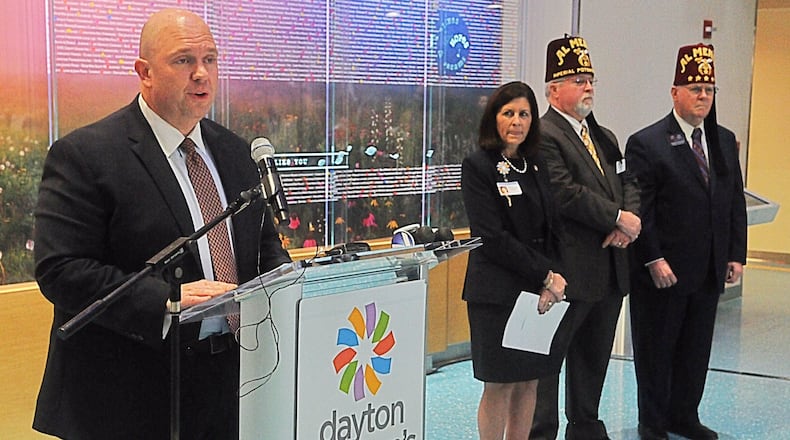Fire safety measures and burn safety awareness has also led to fewer U.S. residents having serious burns. There are now around 120 fire deaths per year in Ohio compared to 220 annual deaths in the early 1980s.
»RELATED: Ohio Senate panel OKs 6-cent hike in gas tax
Dr. Travis Perry, medical director for the Regional Adult Burn Center at Miami Valley Hospital, said fire safety and education has played a tremendous role in the decline in serious burns.
“Burn centers across the nation have seen a decrease in the number of large burns that occur and a lot of that had to do with education in regards to safety,” Perry said.
Shriners, which had been in Cincinnati for 50 years, announced March 14 that it was working on a deal to move to Dayton Children’s main campus. The agreement is not yet finalized.
Shriners intends to operate as a hospital within a hospital, leasing a space that had been home to the pediatric intensive care unit before it moved to another part of the campus. Cincinnati Shriners Hospital Administrator Mark Shugarman said at the time that with demand for inpatient burn care declining, the planned changes were “necessary to ensure that our hospital can continue to provide the finest pediatric specialty care for the next 50 years.”
Burn centers around the U.S. are seeing treating smaller burns on an outpatient basis. Better pain managment protocols mean more patients can go home instead of getting IV pain medication. Providers are also able to make better calls on whether second degree burns can heal without surgery.
“Twenty, 30 years ago, smaller burns used to get admitted to the hospital for wound care but also for helping to control the patient’s pain. We’ve gotten better with taking better with smaller burns with better pain control with pain protocols and regimens that patients tend to do pretty well with on an outpatient basis,” Perry said.
Other Ohio burn centers have seen similar changes. Dr. Amalia Cochran who heads The Ohio State University Wexner Medical Center Burn program, said when she was a resident around 2000, wound dressings needed to be changed once or twice a day. Now burn dressings can stay on longer — maybe five or seven days.
»RELATED: DSW rebranding under a new company name
“If you’ve got a three year old who has got a scald burn, I know what I’m going to pick if someone offers me a durable dressing that I don’t have to change once or twice a day,”said Dr. Amalia Cochran who heads The Ohio State University Wexner Medical Center Burn program.
Burn patients are also leaving the hospital sooner. From 2008 through 2017, the American Burn Association said the average length of stay for women declined from 9.4 days to 7.3 days, while that for men went from 9.5 to 8.5 days.
Patients head to surgery quicker, now that doctors know it is better to remove burn tissue and do skin grafts earlier, said Perry.
“So we try to get to the patients within a 48 hour window,” Perry said. “Thirty, 40 years ago, patients used to be in the hospital for a week before they were taken to the operating room to do excision and grafting.”
Burn care evolving
As burn care improves and survival rates increase, Cochran said practitioners are increasingly looking at the long-term quality of life for burn survivors and improving rehabilitation. There’s also innovative research being done to move away from the painful process of harvesting healthy unburned skin to use for treating burned areas and looking at other possibilities like using patient’s own skin cells as a sprayable product.
“Burn care is in a really exciting phase right now in just how it’s evolving, and I think a consequence of that has been there has been a lot of changes in our practice patterns,” Cochran said.
The decline in major burns has led to many centers expanding to treat more than just burns.
Shriners has a number of other specialties such as such as treating cleft lip and palate, specialty wound treatment, and plastic and reconstructive surgery.
At Miami Valley Hospital, the burn unit also provides specialty wound care. Burns are also complex wounds, so Perry said similar skills are needed for treating other conditions such as necrotizing soft tissue infections, which can mean serious wounds from tissue death.
“Because there has been a decrease in burns nationwide, burn centers have turned to the skill set that they do best and that is healing large, complex wounds,” Perry said. The burn center sees about 5,000 patients in the outpatient clinic every year and about 200 burn admissions a year.
Efforts to cut back on serious burns, including childhood burns, have also been successful. Awareness campaigns have popularized important prevention measures such as keeping stove top handles turned inward, using electrical outlet covers and keeping chemicals and cleaners out of reach from children or locked.
PHOTOS: Thousands of bikers attend funeral for former Outlaw Motorcycle Club president
Cory Paul, Red Cross Dayton chapter executive director, said his group meets with people to teach them how to escape from home fires, making sure household members know their escape plan and are aware of two ways out of each room. The group organizes volunteers to install free smoke alarms each year upon request at their Sound the Alarm event, which this year is April 27 to May 12.
“We teach them how to maintain and listen to their smoke alarms and that does have a bearing on less injury and less death,” he said.
FIVE FAST READS
• Prominent Oakwood boutique set to close
• Burlington closes area store permanently
• Gas prices surged 30 cents in Dayton area: Will it continue?
About the Author
